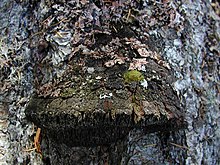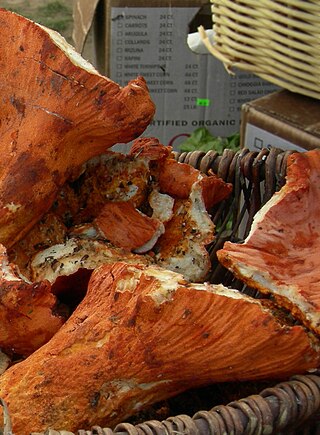
Hypomyces lactifluorum, the lobster mushroom, contrary to its common name, is neither a mushroom nor a crustacean, but rather a parasitic ascomycete fungus that grows on certain species of mushrooms, turning them a reddish orange color that resembles the outer shell of a cooked lobster.

Laetiporus sulphureus is a species of bracket fungus found in Europe and North America. Its common names are crab-of-the-woods, sulphur polypore, sulphur shelf, and chicken-of-the-woods. Its fruit bodies grow as striking golden-yellow shelf-like structures on tree trunks and branches. Old fruitbodies fade to pale beige or pale grey. The undersurface of the fruit body is made up of tubelike pores rather than gills.
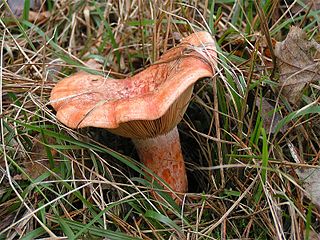
Lactarius deliciosus, commonly known as the delicious milk cap, saffron milk cap and red pine mushroom, is one of the best known members of the large milk-cap genus Lactarius in the order Russulales. It is native to Europe, but has been accidentally introduced to other countries along with pine trees, with which the fungus is symbiotic.

Suillus luteus is a bolete fungus, and the type species of the genus Suillus. A common fungus native all across Eurasia from Ireland to Korea, it has been introduced widely elsewhere, including North and South America, southern Africa, Australia and New Zealand. Commonly referred to as slippery jack or sticky bun in English-speaking countries, its names refer to the brown cap, which is characteristically slimy in wet conditions. The fungus, initially described as Boletus luteus by Carl Linnaeus in 1753, is now classified in a different fungus family as well as genus. Suillus luteus is edible, though not as highly regarded as other bolete mushrooms. It is commonly prepared and eaten in soups, stews or fried dishes. The slime coating, however, may cause indigestion if not removed before eating. It is often sold as a dried mushroom.

Coprinus comatus, commonly known as the shaggy ink cap, lawyer's wig, or shaggy mane, is a common fungus often seen growing on lawns, along gravel roads and waste areas. The young fruit bodies first appear as white cylinders emerging from the ground, then the bell-shaped caps open out. The caps are white, and covered with scales—this is the origin of the common names of the fungus. The gills beneath the cap are white, then pink, then turn black and deliquesce ('melt') into a black liquid filled with spores. This mushroom is unusual because it will turn black and dissolve itself in a matter of hours after being picked or depositing spores.

Rhodofomes cajanderi is a widely distributed species of bracket fungus. Commonly known as the rosy conk due to its rose-colored pore surface, it causes a disease called a brown pocket rot in various conifer species. It is inedible. It is widespread in western North America, with more prevalence in southern climates. It has a particular preference for higher-altitude spruce forests.
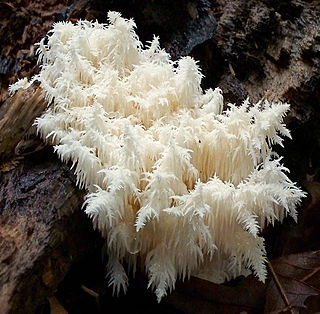
Hericium coralloides is a saprotrophic fungus, commonly known as coral tooth fungus or comb coral mushroom. It grows on dead hardwood trees. The species is edible and good when young, but as it ages the branches and hanging spines become brittle and turn a light shade of yellowish brown.

Phaeolus schweinitzii, commonly known as velvet-top fungus, dyer's polypore, dyer's mazegill, or pine dye polypore, is a fungal plant pathogen that causes butt rot on conifers such as Douglas-fir, spruce, fir, hemlock, pine, and larch. P. schweinitzii is a polypore, although unlike bracket fungi the fruiting body may appear terrestrial when growing from the roots or base of the host tree.
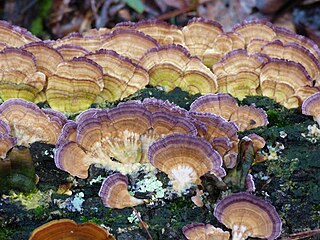
Trichaptum biforme, commonly known as the violet-pored bracket fungus, purple tooth, or violet toothed polypore, is a species of poroid fungus in the order Hymenochaetales. It is a saprobe that decomposes hardwood stumps and logs. It has a violet colored edge that fades with age. It is inedible. It is widely distributed and occurs on at least 65 tree hosts, but rarely on conifers. It is sometimes confused with Trichaptum abietinum, which grows almost exclusively on conifers.
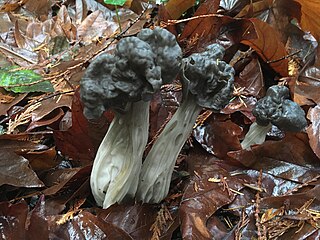
Helvella lacunosa, known as the slate grey saddle or fluted black elfin saddle in North America, simply as the elfin saddle in Britain, is an ascomycete fungus of the family Helvellaceae. It is one of the most common species in the genus Helvella. The mushroom is readily identified by its irregularly shaped grey cap, fluted stem, and fuzzy undersurfaces. It is usually found in Eastern North America and in Europe, near deciduous and coniferous trees in summer and autumn.

Phellinus igniarius, commonly known as the willow bracket, fire sponge,false tinder polypore, or false tinder conk, is a fungus of the family Hymenochaetaceae. Like other members of the genus of Phellinus, it lives by saprotrophic nutrition, in which the lignin and cellulose of a host tree is degraded and is a cause of white rot.

Hydnellum aurantiacum is an inedible fungus, commonly known as the orange spine or orange hydnellum for its reddish orange or rusty red colored fruit bodies. Like other tooth fungi, it bears a layer of spines rather than gills on the underside of the cap. Due to substantial declines in sightings, this species is listed as critically endangered in the United Kingdom.

Grifola frondosa is a polypore mushroom that grows at the base of trees, particularly old growth oaks or maples. It is typically found in late summer to early autumn. It is native to China, Europe, and North America.

Suillus brevipes is a species of fungus in the family Suillaceae. First described by American mycologists in the late 19th century, it is commonly known as the stubby-stalk or the short-stemmed slippery Jack. The fruit bodies (mushrooms) produced by the fungus are characterized by a chocolate to reddish-brown cap covered with a sticky layer of slime, and a short whitish stipe that has neither a partial veil nor prominent, colored glandular dots. The cap can reach a diameter of about 10 cm, while the stipe is up to 6 cm long and 2 cm thick. Like other bolete mushrooms, S. brevipes produces spores in a vertically arranged layer of spongy tubes with openings that form a layer of small yellowish pores on the underside of the cap.

Pholiota malicola, commonly known as the forgettable pholiota, is an inedible species of fungus in the mushroom family Strophariaceae. Originally called Flammula malicola by mycologist Calvin Henry Kauffman in 1926, it was transferred to the genus Pholiota by Alexander H. Smith in 1934. It is found in North America and Australia.

Pholiota aurivella, commonly known as the golden pholiota, is a species of fungus in the family Strophariaceae that is found in native forest of New Zealand, southern Canada, and in the United States. It is frequently found in the American West and Southwest, especially in late summer and fall. Most field guides list it as inedible, with one reporting that it contains toxins which cause gastric upset. According to David Arora, the taste resembles "marshmallows without the sugar." It is sticky or slimy when moist and grows in clusters on live or dead trees.
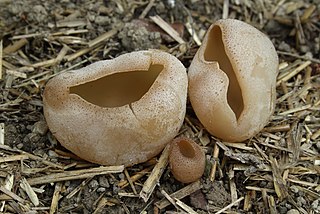
Peziza vesiculosa, commonly known as the common dung cup, is a species of apothecial fungus belonging to the family Pezizaceae.

Leucoagaricus rubrotinctus, commonly known as the red-eyed parasol, is a widespread species of fungus in the family Agaricaceae. It was described as new to science in 1884 by American mycologist Charles Horton Peck as Agaricus rubrotinctus. Rolf Singer transferred it to the genus Leucoagaricus in 1948. The fungus may be a complex of several closely related species. It is inedible.

Suillus caerulescens, commonly known as the douglas-fir suillus is an edible species of bolete fungus in the family Suillaceae. It was first described scientifically by American mycologists Alexander H. Smith and Harry D. Thiers in 1964. It can be found growing with Douglas fir trees. Its stem bruises blue, which sometimes takes a few minutes.
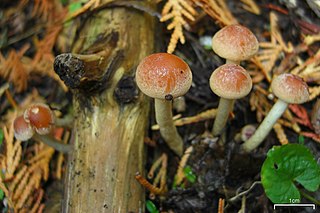
Pyrrhulomyces astragalinus, commonly known as the pinkish-orange pholiota, is a species of fungus in the family Strophariaceae. It was first described scientifically in 1821 by Elias Magnus Fries as a species of Agaricus. Rolf Singer transferred it to the genus Pholiota in 1951 and the species was transferred to its present genus in 2020 by E.J. Tian & Matheny. The fruitbodies of the fungus have pinkish-orange caps measuring 2–5.5 cm in diameter. The flesh is orange, blackening in age, with a bitter taste. They produce a reddish-brown spore print, causing it to be placed in its genus rather than Hypholoma, which it resembles. The spores are oval to elliptical, smooth with thin walls, and measure 5–7 by 4–4.5 µm. In North America, the fungus is found in the United States and Canada. In Europe, it has been recorded from France, Sweden, and Switzerland. Its mushrooms usually grow singly or in small clusters, sometimes on conifer logs.
